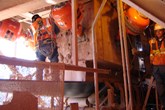Dust levels reduced at mines by Weba technology
Published by Stephanie Roker,
Editor
Global Mining Review,
In the interests of workplace health and safety, Weba Chute Systems has developed and patented certain flow designs for its equipment that keep dust levels as low as possible. According to Izak Potgieter of Weba Chute Systems, it is especially the smaller particles of around 0.3 micron in size that have the most serious impact on human health.
“Spores and contaminants associated with dust and aerosol can adversely impact human health, causing a range of issues from respiratory infections to toxic exposure,” says Potgieter. “In particular, the transport of metals and metalloids in atmospheric dust around mining operations may lead to increased human exposure to toxic contaminants.”
The company has therefore invested in the latest technology to profile the dust secretion of conventional chutes used in mines, showing how the custom-designed Weba chutes address this occupational hazard.
“Dust secretion has been a major issue for most mines,” he says. “When they invest in a Weba Chute System solution, we apply our latest technology to profile the dust secretion of the conventional chute, and compare this to the Weba chute once we have installed it.”
He notes that Weba Chute Systems has monitored and measured dust secretion at numerous plants and sites in order to do a full analysis of dust particles being generated during the transportation of minerals on conveyors and through chutes.
“Using a handheld dust meter, we are able to gather data in 30 sec. intervals, with 0.003 split seconds per measurement over a duration agreed with the customer,” he says. The data is then profiled into a scatter plot, considering factors like lump size, belt speed, relative humidity, wet-bulb temperature, wind conditions and material type.
He says that a normalised profile can be created after the scatter data has been calculated, showing dust versus lump size in increasing order; this plots the data in such a way that the customer can easily reference the prevailing dust levels against the lump size.
“The lump size will affect the dust levels, based on size, speed and material type and factors are calculated for each of these aspects,” he says. “Belt speed will also affect the dust levels, depending on the tonnage per hour traveling through the chute; the tonnage per hour is in turn linked to the material type and lump size.”
By ensuring that its chutes are engineered and designed according to the specific transfer and ore application, Weba Chute Systems can ensure ultimate flow control, managing the velocity and impact of the material, and reducing wear and tear on the chute. This is turn reduces spillage, dust, noise and conveyor damage.
Read the article online at: https://www.globalminingreview.com/mining/18012019/dust-levels-reduced-at-mines-by-weba-technology/
You might also like
Martin Engineering’s new Australian Managing Director shares industry insights
Martin Engineering has hired Darren Gilbert as Managing Director of its Australian Business unit and released a Q&A in which he shares some of his industry insights and experience.


